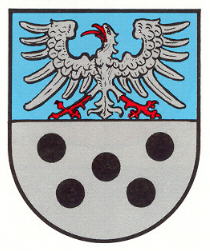Herschberg: Difference between revisions
Jump to navigation
Jump to search
Knorrepoes (talk | contribs) No edit summary |
Knorrepoes (talk | contribs) m (Text replace - "[[Literature" to "{{media}} [[Literature") |
||
| Line 21: | Line 21: | ||
The village historically belonged to the Counts of Leiningen, which is symbolized by the eagle in the upper half. The lower half is taken from the arms of the Lords of Sickingen, although the village never belonged to these lords. The balls are added as the village is situated on the Sickinger Höhe range. | The village historically belonged to the Counts of Leiningen, which is symbolized by the eagle in the upper half. The lower half is taken from the arms of the Lords of Sickingen, although the village never belonged to these lords. The balls are added as the village is situated on the Sickinger Höhe range. | ||
{{media}} | |||
[[Literature]] : Debus, 1988 | [[Literature]] : Debus, 1988 | ||
Revision as of 22:49, 8 July 2014
| Heraldry of the World Civic heraldry of Germany - Deutsche Wappen (Gemeindewappen/Kreiswappen) |
HERSCHBERG
State : Rheinland-Pfalz
District (Kreis) : Südwestpfalz
Verbandsgemeinde : Verbandsgemeinde Wallhalben
Official blazon
Von Blau und Silber geteilt, oben ein rotbewehrter silberner Adler, unten fünf schwarze Kugeln 2:1:2.
Origin/meaning
The arms were granted on November 29, 1950.
The village historically belonged to the Counts of Leiningen, which is symbolized by the eagle in the upper half. The lower half is taken from the arms of the Lords of Sickingen, although the village never belonged to these lords. The balls are added as the village is situated on the Sickinger Höhe range.
Contact and Support
Partners:
Your logo here ?
Contact us
© since 1995, Heraldry of the World, Ralf Hartemink 
Index of the site
Literature : Debus, 1988











